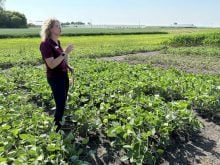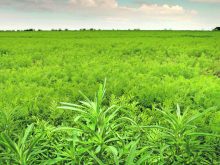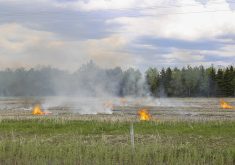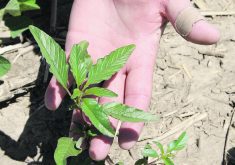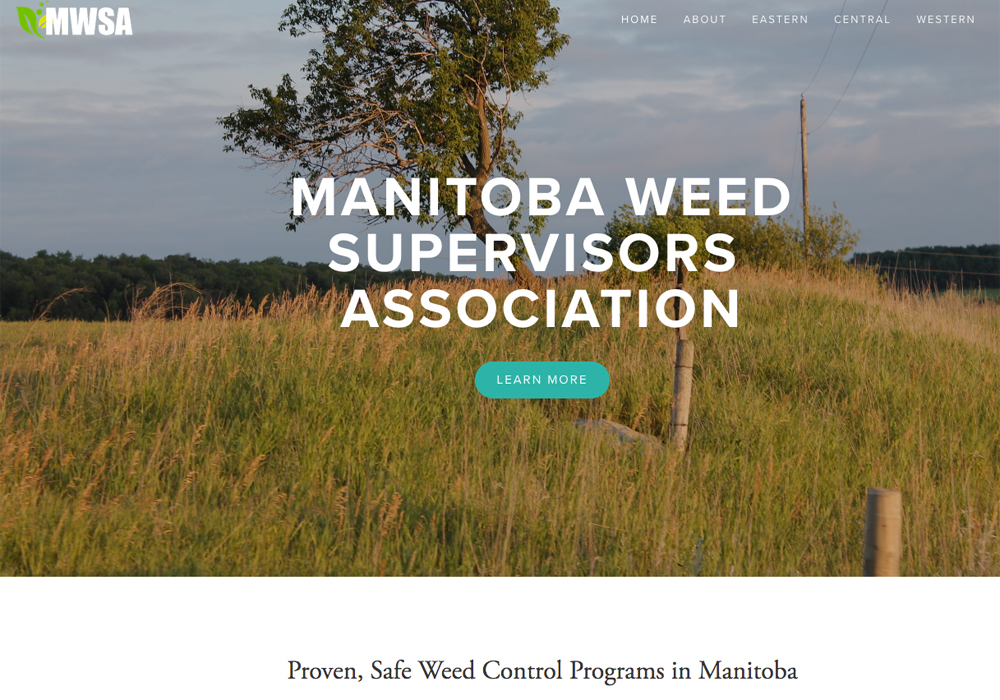Using goats to control weeds is called a great option for urban parks, but those involved say there are definitely challenges
Seeing a goat chewing vigorously on a leafy spurge blossom in its mouth brings a smile to Jackie Cardinal’s face.
The invasive weed is a problem in riverside parks within the City of Lethbridge, and Cardinal, the city’s parks natural resource co-ordinator, is pleased to see that goats are now among the control measures.
“For this project we really want to add another spoke to our invasive species management,” she said while observing a flock of 200 goats munching weeds in Indian Battle Park.
“We do some spraying, we do some biological controls. We’ve tried several different chemical products. In the river valley it’s a lot more sensitive. We wanted to kind of scale back some of the chemical applications for obvious reasons. And the goats just seem like a great idea.”
The goats belong to the Creekside Goat Co., operated by Robert Finck of Magrath, Alta., about 40 kilometres from Lethbridge.
Using sheep or goats for weed and brush control is not a new concept, although it is relatively new for those purposes in urban municipalities. Finck said there are a few unique requirements in Lethbridge’s busiest riverside park.
“People’s dogs on leashes are probably my number one concern because every little yappy dog will want to run in and move them around and do stuff,” he said.
“So the electric fencing actually keeps everything out as much as it keeps my goats in.”
Finck is running two flocks of goats in Lethbridge parks this summer. One is in a fenced and more remote park in the city’s north, and will be resident there around the clock for the next few weeks under supervision of a herder.
Read Also

Farming Smarter receives financial boost from Alberta government for potato research
Farming Smarter near Lethbridge got a boost to its research equipment, thanks to the Alberta government’s increase in funding for research associations.
However, a 200-head flock in Indian Battle Park is loaded up each night and taken back to Magrath, only to return the following day to continue weed feeding.
“It is what it is,” said Finck about the extra work involved in loading, transporting and unloading twice a day.
“This is the safest way for me to be able to do this.”
His contract with the city reflects that effort, which Cardinal said was necessary because of the nature of park use.
“There’s a lot of overnight traffic. Transient people walk through here at night. There’s no gate to this side of the park, so we just weren’t comfortable having animals down here overnight,” she said.
“If it was a place where we could control the traffic in and out overnight, then we would have been more comfortable with it.”
Finck’s flock was just getting used to the park’s range of feedstuffs on July 3. This particular group was in training to eat leafy spurge, and there were plenty of the distinctive greenish-yellow weeds to be had. A half-acre enclosure using temporary fencing forced the animals to eat all that was available.
Once the goats get a taste for spurge, they choose it over other forages.
“Goats are actually more picky than you think,” Finck said.
“They eat what they know. Once they get on spurge and see how much they like it, then it becomes their top (food). The first thing they ate was the wormwood. They came right down and destroyed any of the wormwood plants because they’ve been taught on it. They’ll be the same with spurge.
“Once they’re hooked on it, we don’t fence them. I’m going to walk them. I’m going to go out all through the park and we’ll do it with horses and dogs, but right now I’ve got to teach them what it is. I won’t leave here until the yellow is gone.”
Cody Metheral, an agri-environmental extension specialist with Alberta Agriculture, said he is hoping to get other municipalities, whether rural or urban, interested in using goats for weed suppression. Spurge flourishes along creeks and rivers, spread by water and flooding, and it can be hard to control using chemicals or mowing because of terrain and the need to preserve trees and other desirable vegetation.
“Robert’s idea might flourish in other areas, other municipalities, other folks that see this (and say), ‘let’s maybe lay off the chemical applications and see what goats do,’ but that means you have to reduce your chemical budget and put it toward goats,” said Metheral.
He also sees an application for fire control. Goats reduce the grass, shrubs and forage that can fuel wildfires, and southern Alberta is no stranger to those, particularly in late fall and winter.
“The fire control is more of a fall application, and that’s interesting too, in that again we’re using mechanical processes to mow grass and keep it short to reduce that fire risk, and if the goats will do that in a cheaper more efficient way, that’s the second part of his business that probably has some potential,” said Metheral.
He hopes to organize an information session in the future for rural municipalities and landowners about using goats or sheep for weed and fire control.
A wildfire in September 2012 forced partial evacuation of some city residents, and wind-driven fires in fall and winter are not uncommon in chinook country.
That’s why Finck has another city contract this fall. The goats will return to forage around the rim of the river coulees.
“It gives me work for the fall,” he said.
“The weeds are done and then you can come in and you can do a lot of fire management. So it keeps me working, but that is something I’ve done a lot with. It interests me a lot.”
Finck, an experienced ranch manager, has worked with goats on fire suppression in the past, some of it in California.
It means the goats will be coming and going in Lethbridge for several weeks this summer and fall, which Cardinal said will please park visitors.
“People are excited to see them in the park. They are asking questions — what are we doing and why are we doing it,” she said.
“It’s a great experience to teach them about the biology down here and what’s supposed to be here and what’s not, and kind of opening their eyes a little bit to the impacts that these invasive species can have, not only on large scale farming and our parks, but that they can have an impact on their yards and the places that they enjoy to recreate.”






